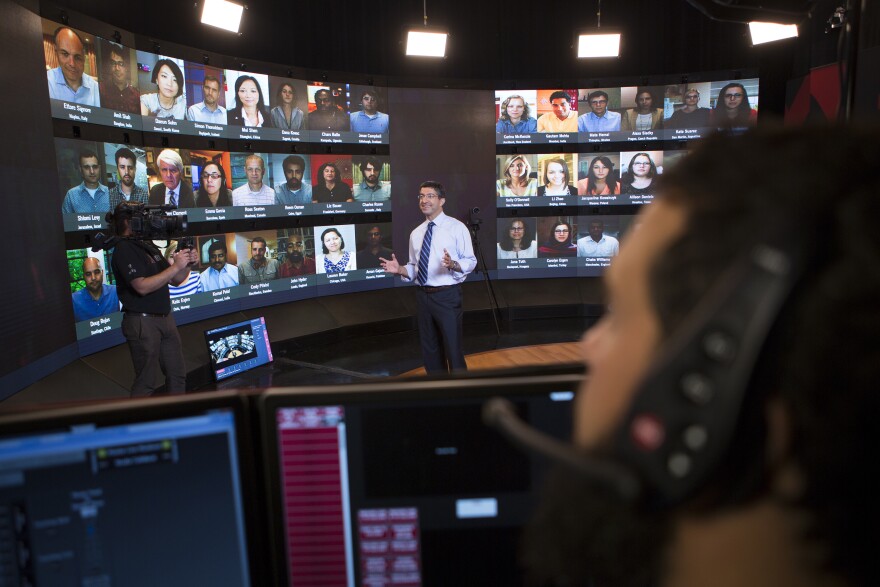It's show time.
"Please try to limit all other background noise, like your cellphone should be muted."
This is a virtual classroom, and that's the stage manager giving last-minute instructions to students. This is unlike any virtual classroom you've probably ever imagined. Behind the scenes, in a control room upstairs, a producer calls the camera shots.
"Stay with him. I'm going to four. Take six."
The Harvard Business School has rented this television studio from WGBH in Boston, and transformed it into a sleek online classroom.
Case Studies Online
The business school is famous for its case-study teaching method, where students dissect actual companies in real-life situations. It's supposed to be interactive, with the professor moderating comments and questions from students. Until now, that pretty much required that students be face-to-face in a classroom on campus.
Professors are experimenting with the same model in this live virtual classroom, with students from all over the world. Sixty monitors bring in students in real-time, from behind their own computers into this single space. There's a businessman in Australia and a web developer in Arizona. Picture a "Hollywood Squares" set-up.
Then, enter stage left — Professor Bharat Anand.
"Big number, or small number? Is this company worth it? What do you think? Is the company worth 50 billion dollars?"
Today's case-study: the ride-sharing phenomenon, Uber.
"The moment we think about this as a taxi service, automatically that limits the size of the market," Anand explains while he paces back-and-forth, facing the bank of TV monitors, a microphone clipped to his tie.
Back in the control room, the producer determines what students see on their own computers. When a student is called on, his or her face pops up on screen.
"Miriam! You're hearing all your colleagues being so negative," Anand says. "You're super positive about Uber, right? Tell us why."
Miriam giggles nervously as she responds in front of the entire class. "Well, I don't know much about the specific number, the billions."
After the TV cameras are off, Anand says Harvard has done what many critics of online education insist can't be done: replicate the intensity of a classroom.
"On one hand, it's very difficult for you and I to mimic the closeness," he continues. "On the other hand, there are some things we can do with technology which we couldn't do in the physical classroom."
Like read students' comments in real-time.
"There's a chat function, which you can basically just be typing in whatever comes to your mind," he explains. "On this little ticker at the bottom of the screen, we as faculty can see what students are writing down."
Right now, most students using the virtual classroom are enrolled in the school's executive education program. Others are undergraduates taking Harvard's online business courses for credit.
Harvard won't say how much all this costs, or how it plans to charge students and viewers in the future.
It Works, Says One Student
Brian Fleming, a senior analyst at the higher education research firm, Eduventures, says that in the midst of all the hype about online learning, Harvard has made a breakthrough.
"It has been debuted to a world that is probably tired of looking for the next big thing" he says.
And yet, Fleming adds, "essentially what they're doing is they're distributing their longstanding commitment to the case-study method, which has always distinguished schools like Harvard. That's really kind of the glue that holds this thing together."
Roy Williams, one of the students in this virtual class, agrees. He says Anand's is the closest he's seen to being in a classroom.
"They had camera angles from pretty much everywhere, so you could see the professor as he is moving around," says Williams, a businessman from Pittsburgh who is enrolled in Harvard's executive education program. "You could see all your classmates on a big board. You essentially had people sitting next to you and in front of you and behind you."
Still, Williams says neither Harvard nor anybody else can replace the real thing: "For me, the preference is always to be in a classroom physically with everybody else and interact with them and interact with the professor face-to-face."
Copyright 2015 GBH




